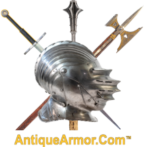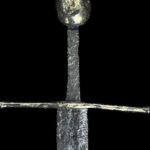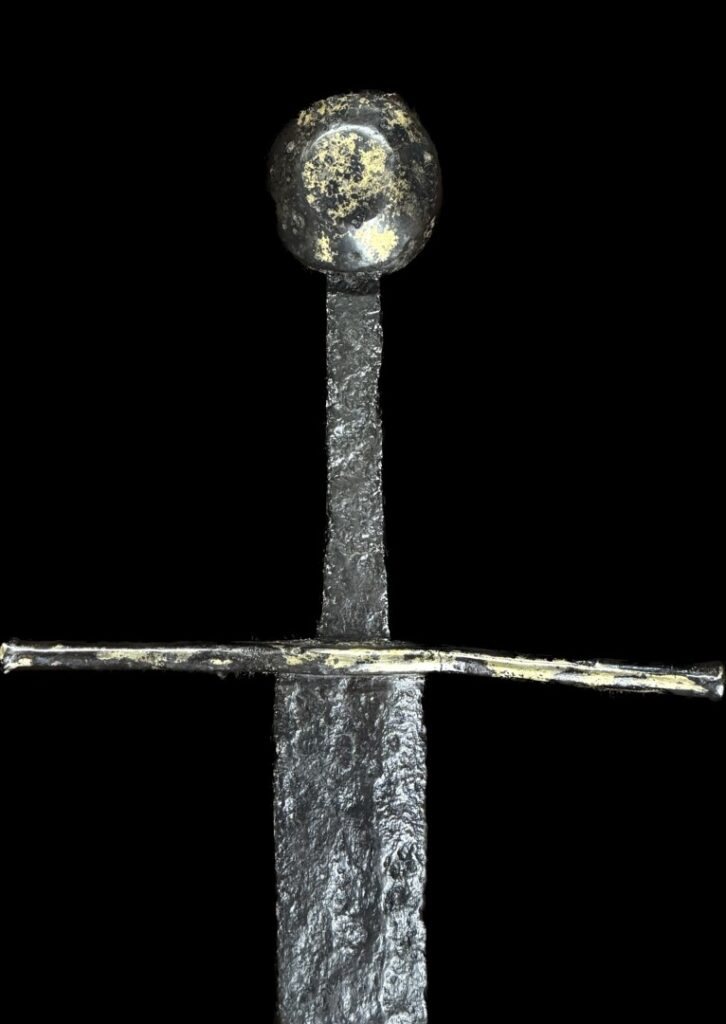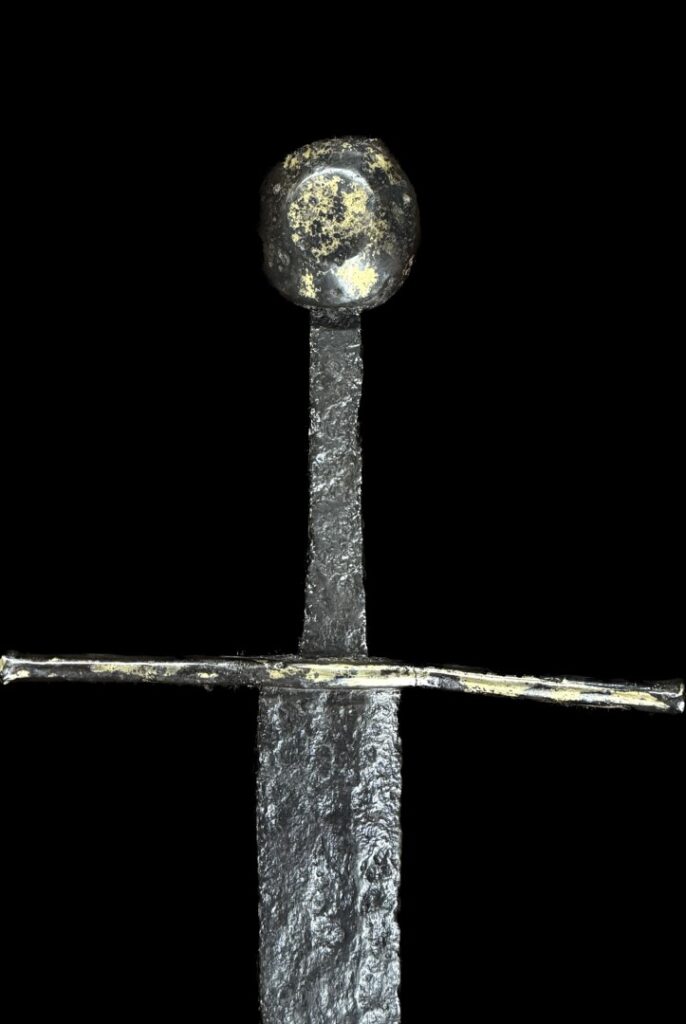1752) A RARE MUSEUM QUALITY GILDED CRU
Introduction: Nothing says Medieval Knight more than a cruciform-shaped hilt on a sword from the time of the Crusades. The fact that this sword has retained most of the hilt’s original gilding and is in superb condition makes this a very desirable sword, even for the most discriminating collector or curator.
Description: An Oakeshott type XIa. Constructed with a wide, flat double-edged blade tapering to a point, a fuller about two-thirds the length of the blade, style 10 solid tubular shaped quillons expanding towards the tip, Style J Hollow Chamfered Disk pommel. Approximately 70% of the gilded hilt remains. This sword is all metal with no resin to hide imperfections.
The Oakeshott Type XI is associated with the early, middle, and late 12th-century. The Type XI has a longer, narrower blade than a Type X, typically measuring around 37 inches in length. The fuller is narrower in the Type XI, and the sword typically has a sharp, acute point. Like the Type X, the Type XI was most often used for cutting or slashing because plate armor was not yet developed, and it was used one-handed. The Type XIa is a Subtype of Type XI with a slightly shorter blade. The blade is broader than a Type XI but retains a narrow fuller. Type XIa usually had a pointed tip and was used with one hand (see page 247 in my book).
Length: approximately 39.5 inches.
Condition: Superb for a ground find. Conserved/restored to museum standards.
Discussion: Today, we associate the sword with the knight of noble birth. That association is essentially correct since swords are weapons of war, and only knights could carry them in times of peace. In some towns, even the nobility could not carry a sword. Merchants and townspeople often carried daggers but not swords. To understand the development of the Medieval and Renaissance sword, there are certain idiosyncrasies, facts, and misconceptions you may need to learn or clarify.
1) Swords, in general, were seldom made by a single swordsmith, even if his mark or signature appeared on it: Swords were mass-produced in centers such as Passau in Lower Bavaria and Solingen in a city near North-Rhine Westphalia. Many blades were made exclusively for export to other countries. Manufacturing centers such as these had water-driven hammers and other mass-producing techniques that produced blades of very high quality, much less expensive, and much faster than a hilt maker could.
2) Swords with good blades (a valuable commodity) were passed down and rehilted. The working life of a sword/blade could be for several generations. Therefore, you could have a blade with a later hilt type. For example, in the Dresden Museum (Militärhistorische Museum Dresden), there is an exceptionally elegant gilded and fluted sword with a hilt dated 1588, yet the blade has an inscription dated 1557. Original hilt? Hardly! In the Wallace Collection, Cat#A672, there is a small sword by Caspar Spat that currently resides in the Castello Sforzesco, Milan. The illustration of this same sword in the Uboldo Collection Sketchbook has a different blade. However, even this blade is over 100 years too late. It can be surmised that the hilt may have been re-bladed at least three times.
3) The catalyst of sword design and evolution was dictated primarily by changes in warfare strategy, civilian combat, and defensive armor worn by both civilians and the military. It is no coincidence that by circa 1420, when full plate armor was coming to fruition, the sword started to develop into a stronger thrusting weapon that could penetrate mail and find openings in armor (see “Chink in the Armor,” pages 83 and 214-215 in my book). Unlike what you see in movies or might have read, swords could not penetrate plate armor. The development of plate armor was key to the changing shape and design of the sword. It was the swordsmith versus the armorer. Before the widespread use of plate armor, swords were almost entirely used for cutting or slashing. Later, when knights and soldiers wore plate armor, swords became sharply pointed for thrusting or stabbing at difficult-to-protect areas.
4) Generalities of the sword. Until the middle of the 13th-century, most swords were made to be wielded with one hand and usually on horseback. Most blades were double-edged; however, some examples are single-edged. The balance of a sword was very important; it made it easier to wield, and the knight tired less because it felt lighter. The counterbalance to the weight of a blade is the pommel. The tang (see page 35 in my book) was usually covered with wood. The wood is covered with leather, wire, or cord. The wood is necessary because it increases the mass of the sword grip, thus making it easier to grip, strike harder, absorb vibrations, and fatigue less. Another critical function of the wood grip is to reinforce the guard by transferring the impact received by the guard (quillon) directly to the pommel (this is why guards are not welded to the blade). In many cases, swords for the very wealthy were made with exceptionally expensive materials for the grip and highly decorated hilts and blades. Certain pommels and guards correspond to specific blades. The most common pommel, the wheel pommel, came into vogue during the middle of the 12th-century, even though it originated about a hundred years earlier. Variants of the wheel pommel included beveled borders and bossed centers. The most common quillons are square in shape and horizontal in length, and they usually swell as they reach the tips.
All my items come with the following:
–Free shipping.
–10-day review period.
–Certificate of Authenticity.
–Autographed copy of my book.
– In the event of an international shipment, we will help assign the lowest correct Customs tariff so you pay the least.
Conclusion: This sword is an excellent addition to any museum or major collection. Swords of this quality seldom make it to the marketplace. When they do appear at auction, they sell for much more than the asking price of this example under discussion.
If you want just one very good Medieval sword for your collection, this is it. This sword is also a superb example of why items should be conserved correctly. The gilding was discovered after careful cleaning. ACT-NOW, this one is too good to pass up.!!!*






